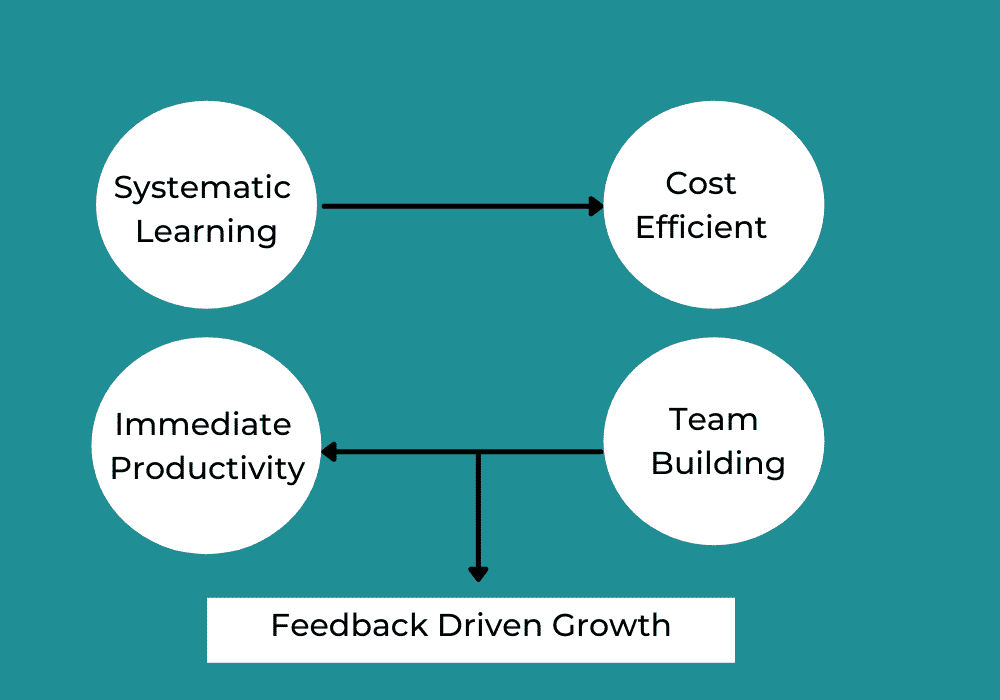On the job training helps facilitate the career growth of an individual and helps strengthen the skills they already possess, thereby reducing training costs the company would otherways incur while individually training each new joiner. This process is now recognised as a standard process in every industry.
What is On the job training?
On-the-job training is a form of training provided at the workplace. During the course of this process a trainee is given a hands-on experience of tools, techniques, machinery, software, materials, or equipment.
This training is provided by the co-worker, training manager, or professional trainers. The motive of on-the-job training is to train the workers on a certain skill set, which they will use in day-to-day tasks.
Also read - Importance of Leadership in organisational growth
Benefits of On the Job Training

- Systematic Learning : On the job training focuses on hands-on experiences with tools and technique rather than theoretical knowledge, which helps trainees to understand industry practices and processes. Trainer provides stepwise instruction and demonstration of the tasks and guides them in the case of any difficulty. This way trainees can try out the tasks on their own and clear their doubts, while being supervised by the trainer.
- Cost Efficient : Company does not need to spend an extra amount for the training sessions, as training is given by internal trainers or senior employees of the company. Also these training are given at job location, so trainees learn by performing their tasks at the actual work environment. The only thing that is needed is a project and a trainer who can guide them what they need to do and how.
- Team Building : Training on the job is given to an employees at their work locations, so which makes it easy for them to connect with their colleagues, co-workers, and employers. Moreover, trainees become more familiar with the workplace and work culture of the company.
- Immediate Productivity : Company wants to onboard new employees as soon as possible rather than wasting their resources on bench. This training process helps employees to learn quickly and gives hands-on experience at their working location itself. This helps the company to onboard them quickly and eliminate the bench time.
- Feedback Driven Growth : During on-the-job training , all the things are supervised under the trainer or the senior employee who guide you throughout your training program and provide feedback as per performance. These feedbacks are very valuable, as it is given by someone who already has hands-on experience and knowledge of the tools and technique. It is a good practice to gather feedback during the training, as it will help you to improve your skills.
Types of On the Job Training
- Job Rotation
- Coaching
- Mentoring
- Job instruction Training
- Apprenticeship Training.
On the Job Training Methods

- Coaching : In this method, the training is given by the senior employee or internal trainer to the new recruit. The trainee can solve their queries and do hands-on through the demonstration and instruction given by their seniors.
- Mentoring : On-the-job training is given by manager or internal trainer, who are well known in their day-to-day tasks. The training is based on a one-to-one training method where the manager or the trainer is considered as a mentor who guides trainees in the situations of difficulty.
- Structured Training : In this training method, the trainer designs the step by step training procedure for the trainee, that includes the job overview, instruction and demonstration for the skill needed in the job role. The trainee can ask doubts and clarify with their trainer and also the trainee can provide their feedback on how effective the program is from them.
- Job Rotation : In this training method, the new recruits are shifted to other connected job roles, to make them well-versed in different job backgrounds. It helps them to learn new tools and technologies and can perform multiple tasks if needed. They can also make good networks with other people in the organization.
- Understudy : In this method, the senior employee trains an assistant or subordinate to perform their tasks and duties in case the former vacates their position due to transfer, promotion, death, or retirement.
Importance of On the Job Training
While some of learn on hands on, some of us maybe visual leaners, whole some of are masters of decoding instructions. On the job training as discussed earlier, breezes an employee/new employee through similar tasks, skillsets and tools that he or she will be expected to deliver results for at work. This process is known to be way more effective than seminars and conference calls.
Difference between On-the-job Training and Off-the-job Training
Introduction
- On-the-job training - Training given at job location by the supervisor or professional trainers having good working experience in their field
- Off-the-job training - Training is given outside the real job location, this training is basically given by an outsourced vendor
Approach
- On-the-job training is based on practical implementation with tools and technologies as per the company requirements.
- Off-the-job training is mostly based on theoretical implementation based on simulations, tests, and videos.
Time and Cost
- On-the-job training takes less time and is inexpensive, as company supervisors, internal trainers, or co-workers personally train new employees
- Off-the-job training is more time taking and expensive as compared to on-the-job training, as companies need to hire external trainers
Many organizations and companies prefer on-the-job training, as it provides hands-on experience at the workplace and retains more information. Additionally, on-the-job training (OJT) helps fresher’s in learning and understanding company policies and work culture.
On-the-job Training Examples
- Co-worker training
- Shadowing
- Internship
- Delegation
On the Job Training for Students or Fresher’s
As a fresher, students may not have any previous experience or hands-on experience with tools and techniques that are used in companies or in industries. For these students, On-the-job training is much more extensive.
Some students get hands-on experience during their academics if they have completed an internship in their desired career path during their college or university. Others may get hands-on on-the-job training during their first job after graduation.
During this process students also learn about professional behaviour, working environment, industry jargon, company hierarchy, dressing sense, communication, and professional relationship with colleagues.
For students or fresher’s the On-the-job training is well designed in a structured format that meets the company requirements. The structured training is more time taking and requires more effort but it is more effective and prepares you properly for your new role.
The curriculum is designed in such a way that it covers all desired tasks which are necessary during the job. The main objective of on-the-job training (OJT) is to use the existing people, tools, and environment to train the new employees to do their jobs.
On the Job Training for Employees
Many companies offer job training or retraining to their employers, managers, business leaders, senior employees, etc. These pieces of training are given by professional trainers who are experts in a particular domain. This training may be related to new technologies or tools that can increase the company productivity and reduce the monotony in their daily work.
Retraining helps employees to find themselves valuable resources for the company; they also stay loyal to the company and invest both time and effort for the growth of the company or organization.
Job training or retraining is an unstructured form of training, this training takes place during weekends of training old employees on new tools or techniques. Some companies organize this training program to recreate the image of the company among the employees.
Companies can also organize some special training for professional employers like motivational training, risk analysis and resolution, project management, team building, communication tactics, financial management, etc.
These trainings are mutually beneficial to both company and employees. So, companies provide training to existing employees as per their requirements or if there are any specific issues that need to be handled.
Learning has no end , hence it is important to always stay up and ready to grab every opportunity that comes your way. Our professional courses designed and delivered by industry experts, will help you in staying hungry for more opportunities in your field of expertise.






